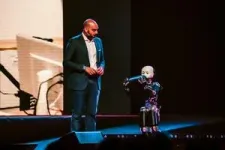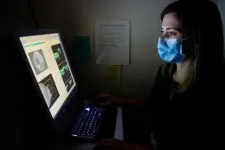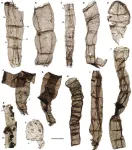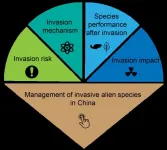(Press-News.org)
Genova (Italy), 24 January 2024 - Over the past four years, the research team at the Artificial and Mechanical Intelligence (AMI) lab at the Istituto Italiano di Tecnologia (IIT-Italian Institute of Technology) in Genova (Italy) has developed advanced avatar technologies, known as the iCub3 system, in continuous testing with real-world scenarios. The system was utilized to enable a human operator to remotely visit locations 300 km away, to entertain the public at events and television appearances, and to compete in the international challenge ANA Avatar XPrize. In a research paper published in Science Robotics today, the group highlights the challenges they faced, and the solutions implemented to develop the avatar system. Their approach highlights how crucial is for research to extend beyond laboratory confines and addresses the difficulties posed by the real-world variability , in order to develop a robust humanoid robotic platform that can soon become part of the economic and productive system. The iCub3 system has already evolved into a new robot, the ergoCub robot, designed to maximise acceptability within work environments.
The research group at the Artificial and Mechanical Intelligence (AMI) lab at the IIT in Genoa (Italy) is coordinated by the Italian researcher Daniele Pucci and comprises about fifty researchers. The iCub3 avatar system is mainly composed of the robot iCub3 - which is one of the last versions of the iCub humanoid robot born in IIT 20 years ago - and the wearable technologies named iFeel that track human body motions. The avatar system has been designed to facilitate the embodiment of humanoid robots by human operators encompassing aspects such as locomotion, manipulation, voice, and facial expressions with comprehensive sensory feedback including visual, auditory, haptic, weight, and touch modalities. It has been developed by IIT in collaboration with the Italian National Institute for Insurance against Accidents at Work (INAIL).
The IIT research group tested and tailored the iCub3 avatar system in three different real scenarios.
In November 2021, during the first test a human operator located in Genoa controlled the avatar at the Biennale di Venezia in Venice (approximately 300 kilometers away) having the possibility to visit remotely the Italian art exhibition. The challenges were about assuring stable remote communications between the two sites, within a limited testing timeframe. Furthermore, the robot's movement and interaction with the surrounding environment had to be cautious and safe, given the delicate nature of the art exhibitions. Pucci’s group utilized the IIT wearable iFeel suit to track the operator’s body motions, and the avatar system transferred these movements onto the iCub3 robot in Venice, allowing it to replicate the user's actions in Genova. The operator exercised precise control over the robot's body parts, including the fingers and eyelids. Additionally, custom haptic devices were employed to allow the operator to feel a hug from the remote location. The transmission was streamed over a standard optical fiber internet connection, resulting in around a hundred milliseconds of delay.
In June 2022, the second test took place at the Italian digital innovation festival, We Make Future Show, presenting additional challenges. The operator in Genova controlled a robot positioned at the festival venue in Rimini (approximately 300 km away). The robot's task involved receiving and transporting a payload from a person while navigating the theater stage before an audience of around 2000 spectators. The performance was conducted live, amidst considerable electromagnetic interference. The IIT research group introduced specialized haptic devices to enable the operator to perceive the weight carried by the robot, and enhanced the robot's expressive abilities, as it had to entertain the audience.
In Novembre 2022, the entire architecture was presented at the All Nippon Airways (ANA) Avatar XPrize competition in Los Angeles. The contest arena resembled a panorama taken from Mars, or another remote planet, suggesting space exploration as a future potential application of avatars. Each avatar was operated by individuals who were not part of the research team and required training just before the race; additionally, they had only 25 minutes to complete 10 different tasks. The iCub3 robot had to perform heavy-duty tasks within a limited time, a situation that pushed the robot to its limits. The IIT team equipped the robot’s hands with sensorized skin to allow it to perceive the texture of manipulated objects. The robot control was designed to be as intuitive as possible, allowing the operator to have direct control over all robot parts and capabilities. For example, the operator could control the robot’s locomotion by walking in place, creating a heightened sense of embodiment.
The experience acquired by Daniele Pucci’s team was fundamental to turn the iCub3 avatar system into a new robot, the ergoCub robot, designed to maximise acceptability within the work environment. The new humanoid ergoCub, currently being developed at IIT, is meant to minimise risk and fatigue in collaborative tasks for workers for industry and healthcare.
END
Mass Eye and Ear physician-researchers show that retinal imaging can help predict a person’s risk of developing ocular, neuropsychiatric, cardiac, metabolic, and pulmonary diseases.
The team also identified genetic loci associated with retinal thinning, which could help develop personalized treatment plans and future therapies for eye diseases such as glaucoma and macular degeneration.
The retina is said to provide a window into a person’s systemic health. In a new study published January 24th in Science Translational Medicine, physician-researchers from Mass ...
In a study published in Science Advances on Jan. 24, researchers led by Prof. ZHU Maoyan from the Nanjing Institute of Geology and Palaeontology of the Chinese Academy of Sciences reported their recent discovery of 1.63-billion-year-old multicellular fossils from North China.
These exquisitely preserved microfossils are currently considered the oldest record of multicellular eukaryotes. This study is another breakthrough after the researchers’ earlier discovery of decimeter-sized eukaryotic fossils in the Yanshan area ...
DURHAM, N.C. – Biomedical engineers at Duke University have demonstrated that one of the most dangerous mutations found in skin cancers might moonlight as a pathway to mending a broken heart.
The genetic mutation in the protein BRAF, a part of the MAPK signaling pathway that can promote cell division, is one of the most common and most aggressive found in melanoma patients. In a new study, researchers show that introducing this mutation to rat heart tissue grown in a laboratory can induce growth.
Repairing ...
This month, the Ecological Society of America spotlights the challenge posed by invasive alien species in China with the release of a Special Feature, “Management of Biological Invasions in China,” in the latest issue of its journal Ecological Applications.
Accelerating rates of biological invasion have led to growing concerns about the destructive impacts of invasive alien species, or IAS, on the environment and human societies. This is especially true in China, which has witnessed a surge in ...
Researchers with the Department of Energy’s SLAC National Accelerator Laboratory, Stanford University and the DOE's Lawrence Berkeley National Laboratory (LBNL) grew a twisted multilayer crystal structure for the first time and measured the structure’s key properties. The twisted structure could help researchers develop next-generation materials for solar cells, quantum computers, lasers and other devices.
“This structure is something that we have not seen before – it was a huge surprise to me,” said Yi Cui, a professor at Stanford and SLAC and paper co-author. “A new quantum electronic property could appear ...
Since the creation of the National Flood Insurance Program (NFIP) in 1968, the U.S. government has paid over $51 billion to cover flood losses. Almost half of these payouts went to just 25 counties, among the fastest-growing counties by population. A new paper published in the Journal of the Association of Environmental and Resource Economists examines whether insuring people against potential flood losses contributes directly to population growth in flood-prone areas. In “Does the National Flood Insurance Program Drive Migration ...
Fresh research into the physics of vibrating nanobubbles reveals that they do not heat up as much as previously thought.
Vibrating nanobubbles have surprising uses as ultrasound contrast agents in cancer diagnosis. They can also be forced to collapse - destroying nearby microscopic contaminants - for waste-water treatment and surface cleaning of delicate microfluidic devices.
The stiffness of a nanobubble as it vibrates is strongly related to their internal temperature, and being able to understand ...
With over 2,780 fishing ports and 993 commercial and industrial ports, Japan faces the challenge of safeguarding these important coastal assets from the destructive forces of tsunamis. A promising solution lies in the form of a movable barrier system, where gates rising from the seafloor act as barriers, protecting ports against tsunamis, storm surges and high waves. However, during natural disasters, power outages may disrupt the electricity needed to operate the gate.
To address this, researchers led by Professor Hiroshi Takagi from Tokyo Institute of Technology have proposed ...
At the beginning of November, The New York Times ran the headline, “America is using up its groundwater like there’s no tomorrow.” The journalists from the renowned media outlet had published an investigation into the state of groundwater reserves in the United States. They came to the conclusion that the United States is pumping out too much groundwater.
But the US isn’t an isolated case. “The rest of the world is also squandering groundwater like there’s no tomorrow,” says Hansjörg Seybold, Senior Scientist in the Department of Environmental Systems Science at ETH Zurich. He is coauthor ...
NEW ORLEANS (Jan. 24, 2024) – A research team from LSU LCMC Health Cancer Center has been awarded a $1.5 million grant to eliminate barriers from cervical cancer prevention. The five-year program combines a $1.2 million award from the American Cancer Society and $75,000 a year for five years investment from LSU Health New Orleans.
Louisiana has one of the highest cervical cancer death rates in the country. Cervical cancer rates are higher in predominantly African American communities represented in both urban (New Orleans) and rural areas of Louisiana. Black women in Louisiana are diagnosed with and die from cervical cancer at a significantly ...







